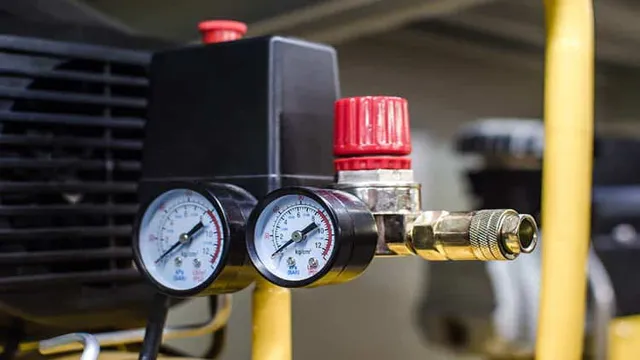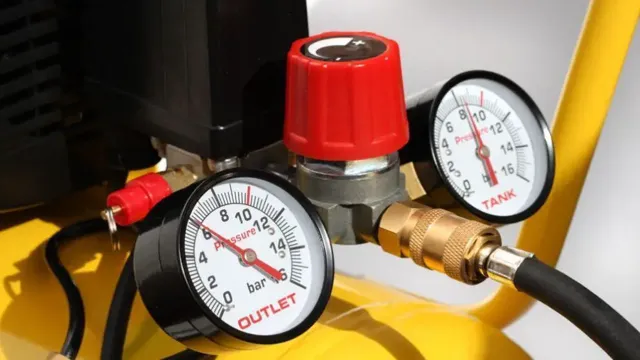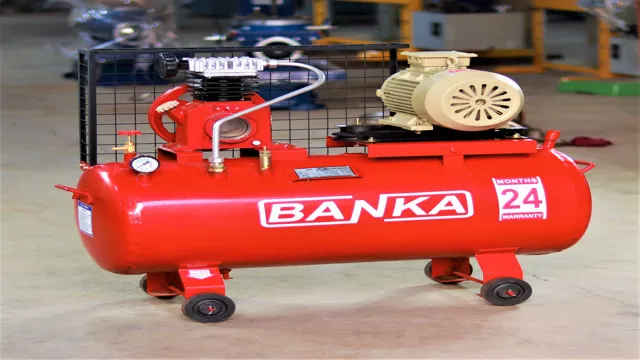How to Adjust Air Compressor Regulator: Step-by-Step Guide for Maximum Efficiency

If you are using an air compressor for a project, you want to make sure it is working at its optimal level. One critical component of an air compressor is the regulator. The regulator controls the amount of air pressure that is coming out of the compressor, so it’s important to make sure it is adjusted correctly.
However, many people may not know how to go about adjusting their air compressor regulator. Fear not, as we are here to guide you through the process step by step and ensure you have the tools to get the best performance out of your air compressor. In this blog post, we’ll cover everything you need to know about adjusting your air compressor regulator, from what it is and why it’s important, to the tools you’ll need and the steps to take.
So, grab a cup of coffee and let’s dive in!
What is an Air Compressor Regulator?
An air compressor regulator is a device that allows you to control the pressure of the air coming out of your compressor. It attaches to the compressor and has a gauge that shows you the pressure level. You can adjust the regulator by turning a knob to increase or decrease the pressure.
Adjusting the regulator is essential because different tools and applications require different pressures. For example, you might need higher pressure levels to power a nail gun but lower levels for a paint sprayer. It’s important to keep in mind that going over a tool’s recommended pressure can cause damage or even be dangerous, so always check the manufacturer’s instructions before using a tool.
By properly regulating your compressor’s pressure, you can ensure that you’re using the right level for your application and prolong the life of your tools. So, understanding how to adjust your air compressor regulator is crucial for any DIY or professional project where you use an air compressor.
Definition and Importance of the Regulator
Regulator, Air Compressor Regulator An Air Compressor Regulator is a device that is used to control and maintain the pressure within an air compressor. It is an essential component of an air compressor that helps in regulating the air pressure that is released from the compressor. The primary function of an air compressor regulator is to control the air pressure and flow to the tool or equipment being used.
It works by reducing the pressure of the compressed air that is coming out of the compressor’s tank. Once it is installed, the regulator allows the user to have control over the air pressure, which is important for the safety and effective functioning of the air-powered tools. The importance of having an air compressor regulator cannot be overemphasized.
It is an essential component of an air compressor that helps in regulating the pressure and flow of the compressed air, making it easier and safer for the user to work with air tools and equipment. Using an air compressor without a proper regulator is not only dangerous but can also damage the tools and equipment. The regulator maintains the required pressure level, thereby preventing overloading, which could lead to equipment failure.
An air compressor regulator is a vital component of an air compressor that ensures the safe and efficient operation of air tools and equipment.

Safety First
An air compressor regulator is an essential component of compressed air systems because it allows for safety and control. It helps regulate the pressure of the compressed air, ensuring that it does not exceed safe levels and preventing any potential damage or accidents. The regulator works by reducing the initial pressure of the air coming from the compressor and releasing it at a controlled and safe level.
This allows for precision in delicate tasks, such as spray painting or using pneumatic tools. Without the regulator, the pressure could fluctuate or even rise to dangerous levels, potentially causing injury or equipment failure. Think of it as a faucet controlling the water flow; the regulator controls the air pressure.
It is important to choose the right regulator for your air compressor to ensure that it functions correctly and keeps you safe.
Tools You Need
Learning how to adjust an air compressor regulator is a crucial skill for any DIY enthusiast or workshop owner. To make this process a breeze, you’ll need a few tools such as a wrench, screwdriver, and air gauge. Start by turning off and unplugging the air compressor to avoid any accidents.
Next, locate the regulator near the pressure switch and use the wrench to loosen the lock nut. Once the lock nut is loose, turn the regulator clockwise to increase the pressure output or counterclockwise to decrease it. Don’t forget to use the air gauge to check the pressure level and make any necessary adjustments.
Once you’re done, re-tighten the lock nut and plug in the air compressor. With these simple steps and the right tools, you’ll be able to adjust your air compressor regulator like a pro and ensure your tools and equipment run effectively.
List of Required Tools
Before starting any DIY project, it’s important to invest in the proper tools. Here is a list of required tools that every DIYer should have in their tool kit. First, a reliable hammer is a must-have.
Opt for one with a comfortable grip and a claw for removing nails. Next, make sure to have a set of screwdrivers in various sizes and types, such as flathead and Phillips head. A good set of pliers can come in handy for a variety of tasks, such as cutting wires and holding objects.
A tape measure is essential for ensuring accurate measurements, and a level can help ensure your project is straight and balanced. Other useful tools to consider include a utility knife, an adjustable wrench, a drill, and safety equipment such as gloves and goggles. With these tools in your arsenal, you’ll be prepared to take on any DIY project that comes your way.
Step by Step Guide
Adjusting the air compressor regulator is a simple process that any DIY enthusiast or professional can do. The air compressor regulator is responsible for maintaining a constant air pressure level, which is essential for the efficiency and safety of any pneumatic tools. Here is a step-by-step guide on how to adjust air compressor regulator.
Firstly, turn off your air compressor and unplug it and disconnect any air tools. Then, locate the air regulator knob, which is usually located at the end of the air hose or on the regulator itself. Turn the knob in a clockwise direction to increase the pressure or counterclockwise direction to decrease it.
Use an air pressure gauge to check the pressure level and adjust to your desired level. Once you have attained your preferred pressure, turn your air compressor back on and test your pneumatic tools. Remember to read the user manual before adjusting the regulator, and always check the pressure gauge before using any tools to ensure safety.
Take care not to overpressurize your tools as it may cause them to malfunction. With these simple steps, you can now adjust your air compressor regulator and enjoy efficient and safe pneumatic tool operations.
Locate your air compressor regulator
If you own an air compressor, you know the importance of having control over your air pressure. That’s why every air compressor comes with a regulator that allows you to adjust the air pressure coming out of your compressor. But if you’re new to air compressors, you might not know where the regulator is located.
Don’t worry; it’s not difficult to find. First, turn off the compressor and disconnect it from its power source. Then, locate the air hose that connects your compressor to the tool or appliance you’re using.
You should see a knob or dial on the hose; this is your air regulator. If you can’t spot it on the hose, look for a separate component near the compressor. Depending on the model of your compressor, this component might look like a valve, a switch, or a lever.
Once you’ve located the regulator, you’re ready to adjust the pressure according to your needs. Remember, it’s important to keep your air compressor regulated to prevent damage or accidents. Always check the manufacturer’s instructions to ensure you’re using your compressor correctly.
And if you’re ever unsure about anything, don’t hesitate to ask for help from a professional.
Release pressure from the air compressor
When it comes to using an air compressor, it’s important to release the pressure properly to avoid potential accidents or damage to the machine itself. Here’s a step-by-step guide on how to safely release the pressure from your air compressor: Turn off the power supply: Before you begin releasing pressure, make sure your air compressor is turned off and unplugged from the power supply.
Bleed the air from the tank: Locate the tank drain valve on your air compressor and turn it counter-clockwise to open it. Allow the air to bleed out of the tank until there is no more pressure.
Open the regulator: On the regulator, turn the adjustment knob counterclockwise to release any pressure inside. You should hear a hissing sound as air is released.
Disconnect the tool or hose: If you have a tool or hose connected to your air compressor, disconnect it before releasing the pressure. This will prevent any sudden bursts of air from causing damage or injury.
Remember that failing to release pressure properly can lead to dangerous situations, so it’s important to follow these steps carefully. By doing so, you can safely use your air compressor for years to come.
Adjust the knob on the regulator
If you want to adjust the flow of gas into your system, the first thing you need to do is adjust the knob on the regulator. This knob is typically located on the top of the regulator and can be turned with your hand. By turning the knob to the left, you can reduce the flow of gas that is coming into your system.
Likewise, by turning the knob to the right, you can increase the flow of gas. It’s important to note that you should only make small adjustments at a time and always monitor the pressure gauge to ensure that your system remains within safe operating limits. Remember, the knob on the regulator is a powerful tool, but it must be used with care and attention to detail.
Test and Adjust Pressure
When it comes to maintaining your tire’s health and safety, testing and adjusting the pressure on a regular basis should be at the top of your priority list. To start, you’ll need a tire pressure gauge, which can be easily found at your local auto parts store. Before you begin testing, ensure that your tires are cold (meaning they haven’t been driven on for at least an hour) as this can affect your readings.
To get an accurate read, unscrew the valve cap and place the gauge firmly onto the valve stem. You should hear a small hiss as air is released, and the gauge will show you the current pressure. If the pressure is too high or too low, use an air pump to adjust as necessary.
Remember that overinflated tires can cause instability and wear the center treads while underinflated tires can cause increased rolling resistance and wear the outer treads. By regularly testing and adjusting your tire’s pressure, you can avoid dangerous blowouts and save significantly on fuel costs in the long run.
Tips for Maintaining Your Air Compressor Regulator
If you own an air compressor, it’s essential to know how to adjust the air compressor regulator properly. The regulator controls the flow of air that passes through the compressor and ensures consistent pressure to operate your tools and equipment. To maintain your air compressor regulator, always start by reading the user manual.
Typically, the regulator has a knob that you can turn to increase or decrease the air pressure. To adjust the regulator, turn the knob clockwise to increase the pressure and counterclockwise to reduce it. Remember to be gentle while making adjustments and never over-tighten the knob.
Additionally, you should regularly clean and lubricate the regulator to keep it running smoothly and prevent rusting or corrosion. By following these tips, you can prolong the lifespan of your air compressor regulator and ensure that it operates efficiently.
Regularly check your regulator
When it comes to maintaining your air compressor, checking the regulator should be at the top of your list. As a crucial component of the air compressor system, the regulator is responsible for controlling the pressure of the air being released. Regularly inspecting and testing your regulator is essential to ensuring that it is functioning correctly and preventing potential safety hazards.
Over time, the regulator can become worn or damaged, causing it to malfunction or fail. By taking the time to check your regulator periodically and making any necessary repairs or replacements, you can prolong the life of your air compressor and prevent costly damage. Remember, a faulty regulator can lead to inefficient operation, decreased performance, and even dangerous accidents.
So keep your compressor running smoothly by giving your regulator the attention it deserves.
Clean the regulator and oil regularly
Maintaining your air compressor regulator is critical to ensure its longevity and efficient operation. One of the essential tips for proper maintenance is to clean it and add oil regularly. Over time, dirt, dust, and debris can accumulate in the regulator, causing it to malfunction and lose accuracy.
To prevent this, it is advisable to disassemble the regulator and clean its components thoroughly with a clean cloth or soft brush. After cleaning, apply a few drops of oil to the moving parts to lubricate them and prevent rust or corrosion. However, make sure not to over-oil the regulator, as it can lead to clogging or leakage.
By following these simple yet effective tips, you can keep your air compressor regulator in top-notch condition, ensuring reliable and consistent performance every time you use it.
Conclusion
Adjusting your air compressor regulator can be as simple as turning a knob, but doing it correctly is no laughing matter. To ensure your compressed air system is running at maximum efficiency, take the time to adjust the regulator properly. With a little know-how and attention to detail, you can take control of your air pressure and blow the competition away!”
FAQs
What is an air compressor regulator and why do I need to adjust it?
An air compressor regulator is a device that controls the amount of pressure that goes into your air tools. You need to adjust it so that you can use your tools safely and efficiently.
How do I know when it’s time to adjust my air compressor regulator?
You may need to adjust your air compressor regulator if you notice that your tools are not working as well as they used to, if they are making strange noises, or if you see a drop in pressure.
What should I do before adjusting my air compressor regulator?
Before adjusting your air compressor regulator, you should make sure that your air tool is properly connected and that your compressor is running smoothly.
How do I adjust my air compressor regulator?
To adjust your air compressor regulator, turn the regulator knob clockwise to increase the pressure and counterclockwise to decrease the pressure.
What is the ideal pressure setting for my air tools?
The ideal pressure setting for your air tools will depend on the specific tool you are using. Consult the manufacturer’s instructions for the recommended pressure range.
Can I damage my air tools if I set the pressure too high?
Yes, setting the pressure too high can damage your air tools and be dangerous. Always consult the manufacturer’s instructions and use caution when adjusting your air compressor regulator.
How often should I check and adjust my air compressor regulator?
You should check and adjust your air compressor regulator as needed, depending on how often you use your tools and the type of work you are doing. It’s a good idea to check it periodically to ensure that it is working properly.



